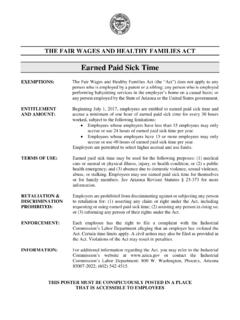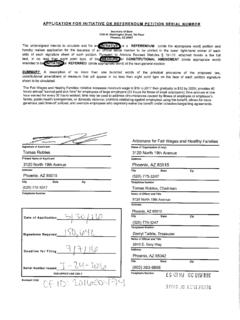Transcription of COOPERATIVE EXTENSION - Arizona Water Well Association
1 November 2012AZ1586 IntroductionThe use of fresh Water storage tanks is common in rural areas of Arizona with limited or diminishing Water resources. Homeowners living in remote areas with low-yield and seasonally dry wells or no wells must depend on Water that is trucked in with tankers and stored on site to cover basic living necessities. Well owners with low-yielding wells may also rely on large holding tanks and booster pumps to collect well Water before home delivery with the aid of a pressure tank. Emergency situations such as fires and Water utilities shortages may also require the short-term storage of fresh Water to cover the basic needs of dispossessed or displaced are several reasons to clean and disinfect Water storage tanks regularly including: to kill or prevent the survival of waterborne pathogens (bacteria, viruses, and other microorganisms) that can cause gastrointestinal and other diseases; to prevent the accumulation of scale and slime (biofilm), which can be sources of contaminants and can also harbor pathogens.
2 And to control the accumulation of sediments and algal growth, which degrade the taste and odor of potable bulletin provides step-by-step methods to disinfect Water storage tanks, tank descriptions, and maintenance tips. In addition, a review is provided of various methods of Water testing for residual chlorine and Water disinfection using chlorine chemicals, ozone, and ultraviolet (UV) light to assist anyone considering the purchase of a home Water disinfection of Storage TanksMaterials: Most of the traditional elevated storage tanks made of redwood and fed by windmills are long gone. Water storage tanks or domestic Water systems in use today are typically made of steel (Fig.)
3 1), fiberglass, or polyethylene (Fig 2). Today, thicker walled carbon steel tanks are made and sold for in-the-ground Water storage, as are ribbed poly tanks (Fig. 2), and reinforced fiberglass tanks. Above-ground storage tanks are typically made out one of three materials: 1) thin-wall, welded, galvanized steel; 2) fiberglass blown around molds; and 3) extruded white, black, and green colored : Custom metal shops can manufacture tanks locally and build them in custom made shapes and sizes. Only companies that have access to the proper polymer materials and special molds can manufacture extruded round polyethylene tanks in large quantities. Molded polyethylene tanks are relatively light in weight, but they are very bulky and difficult to package in quantity and transport very far.
4 Tanks that can hold larger volumes of Water are usually brought on site and permanently mounted in place. Tanks that are manufactured primarily for transporting potable Water are often made of a translucent polyethylene with a white tint. The Water level is clearly visible through the walls of the tank, which Water Storage tank DiSinfection, teSting, anD MaintenanceJanick F. Artiola, , Channah Rock, , and Gary Hix, RGCOLLEGE OF AGRICULTUREAND LIFE SCIENCESCOOPERATIVE EXTENSIONF igure 1. Above-ground steel Water storage tank painted white to reflect light. g. 2. Underground, polyethylene Water storage tanks. g. University of Arizona COOPERATIVE Extensionis convenient for knowing how much Water is still available.
5 These tanks are typically not baffled (no internal walls) and the Water inside it can slosh around during transportation often making it difficult to control the vehicle transporting it. The translucent material of these tanks will also allow sunlight to penetrate and can facilitate the growth of algae inside the : Water storage tanks must have openings for the entry and exit of Water . The opening used to facilitate Water entry is commonly located at the top of the tank to ensure the existence of an air gap that does not allow Water to be siphoned back down the well. Water that is put into the tanks whenever it is available, and removed when it is needed can cause changes in shape (deformities) on the base and the sidewalls of the tanks.
6 Seasonal changes in ambient temperature can cause expansion and contractions of storage tanks. For this reason special bulkhead fittings are used that are both strong and yet flexible enough to allow for the expansion and contraction or slight movements of the tanks. The seal around the inspection hatch is typically the hardest area to seal tightly, especially the tanks made of welded thin steel. Fiberglass and poly tanks typically have pre-manufactured coarse thread lids or bolted hatches incorporated into their walls forming tighter or below-ground Water storage tanks must also have a ventilation port that allows the air inside the tank to escape as the tank is filled with Water , and to re-enter the tank as it is emptied.
7 This ventilation port can double as the safety overflow relief port in case the tank is being overfilled with Water . Screens over the ventilation port can keep out small animals, rodents, and most insects, but not fine dust and microorganisms. One of the most probable paths for dust and microorganisms to get inside any potable Water storage tank is through one of the many Contaminants Present in Water Storage TanksChemicals and Organic Matter: Warm Water temperatures are commonly found inside Water storage tanks. Warm Water favors corrosion (Fig. 3), scale formation, and the growth of algae and other microorganisms. Over time, Water storage tanks can accumulate organic (carbon-based) and inorganic residues and sediments, which can affect the taste, odor, and potability of the stored Water .
8 Sediments that accumulate at the bottom of well casings can be pumped to Water storage tanks. These sediments come from the aquifer and are usually composed of fine sand, silt, and clay size particles. Although harmless, these soil materials can carry chemical contaminants and microorganisms (attached to them) into the storage tanks. Over time, changes in Water oxygen content, pH, and temperature can produce new residues (from precipitation and corrosion) forming scale that damages storage tank components. These mineral crusts can trap or release contaminants into the Water , depending on many factors such as Water oxygen content, pH, and temperature changes. Organic matter, found in the tissue of living and dead organisms, can be introduced to Water storage tanks several ways including: from naturally-occurring organic matter in the aquifer Water , from aquifer contamination (such as septic system seepage), from the growth of microorganisms inside the tank itself, and from air dust.
9 Slime, often accompanying mineral residues, is produced by an overgrowth of bacteria and : Microorganisms usually enter Water tanks carried by aquifer sediments and improperly sealed tank covers or breathing outlets improperly designed or not fitted with particle filters. Arizona s dusty environment often generates significant amounts of dust, which can enter Water tanks and contaminate the Water with several organisms including: green algae, bacteria, viruses, protozoa, fungi, pollen, and spores. Potable Water often contains sufficient nutrients (nitrate, phosphate, and other minerals) to allow for growth of green algae (some light is needed) and filamentous bacteria, which produce slime (biofilm) (Fig 4).
10 Although many bacteria that are naturally occurring in Water are not usually harmful, pathogenic bacteria, viruses, and parasites Figure 3. Inside of a Water storage tank with visible rust. g. 4. Inside a Water storage tank nearly empty, sediment and algae growth visible. g. University of Arizona COOPERATIVE Extensioncan be found in Water due to fecal matter contamination. This type of contamination is indicated with a Water quality test that targets the presence of fecal indicator bacteria Esherichia coli or E. coli. If tests positive in the Water , there is a high likelihood of fecal contamination and the possible presence of other pathogens. A pathogen is an organism that can make you sick. For example, some pathogenic types (strains) of bacteria can cause severe gastrointestinal problems to humans and livestock.




